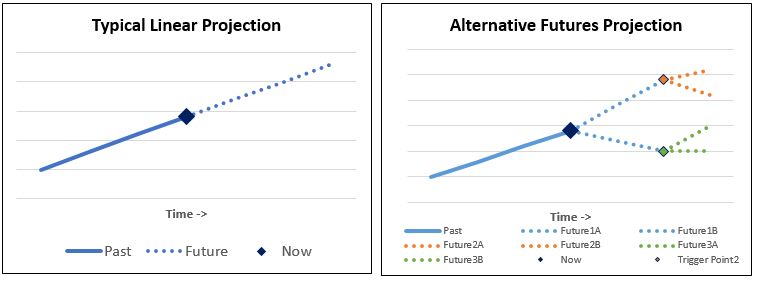The Strategic Facility Guide is essentially about measurement and planning. The purpose of the Guide is to help bridge the gap between these two mutually exclusive activities. They are exclusive in time – one is future and one is present. An attempted measurement of a plan is really a projection – a presumed or defined metric, not an actual one.
- Planning is the activity of identifying a desired future state, or the desired response to a potential future situation. The Plan is the desired outcome to achieve.
- Measurement is the activity of quantifying an existing state to reduce uncertainty about it (more on this later). The Metric is the dimension and precision of the measurement.
Measuring
We find definitions like the following for measurement: the assignment of a number to a characteristic of an object or event, which can be compared with other objects or events; measure is the extent, dimensions, quantity, etc., of something, ascertained especially by comparison with a standard; any standard of comparison, estimation, or judgment.
For all practical purposed, the scientific crowd treats measurement as a set of observations that reduce uncertainty where the result is expressed as a quantity. 1
In this context, alternative measures of the distance between two buildings could be “about 300 yards” (based on visual estimate), 270 yards (based on pacing it off), and 262.1 yards (based on a surveyor’s measurement. The difference between these measurements is their precision and likely amount of error. Clearly, it is easier to estimate some things than others, but the point is if the level of precision of “about 300 yards” is good enough, why bother to invest the resources to find out it is really 262.1 yards?
Equally important to the level of precision is what is being measured. We will discuss this more in a later article on Facility Assessments.
Planning
We find definitions like the following for planning: the process of thinking about and organizing the activities required to achieve a desired future goal; to arrange a method or scheme beforehand; forethought.
Implicit in planning is that it takes place within the context of our perception of the future. A challenge we face as humans is that in spite of our wonderful capacity for imagination, we often perceive the future as just an extension of the status quo. This leads to the standard linear projection that underlies many plans. The premise is that the future will continue to be more of the past.
Linear projection is fine in some cases, but in dynamic and high risk situations the value of planning is to consider changing conditions, even the “wild card” scenario.* In these conditions, the premise is that alternative futures could be much different than the present, because of some changing condition. A plan developed for the dynamic environment might have different options depending upon the action at the time (“trigger point”). The number of options can make it problematic to plan very far forward, requiring frequent updates and course corrections.
For parts of your organization that are facing dynamic change, there may be limited value in the precision of knowing the current situation until your reach the trigger point. Conversely, the metric itself could be the trigger point prompting you to take some planned action.
Examples of these might be 1) there is no reason to know the market value of a store until the sales volume falls below a designated level, and 2) once a building occupancy reaches 95% of capacity it is time to do a space audit.
Our position in this article is that both measurement and planning are important, complementary activities. This is not an either/or situation. You need to know where you are (metric) and where you want to be (plan) in order to develop a strategy to get from here to there. In a stable environment, planning can often be limited until key metrics suggest action. In a dynamic environment, you may only have the time and need for selected metrics based on the situation and your plan. In both cases, an agile strategic facility approach lets you get just enough of each to make informed facility investment decisions.
1 Source: How to measure anything: finding the value of intangibles in business,
by Douglas W. Hubbard, John Wiley & Sons, Inc., 2007, p. 21.

